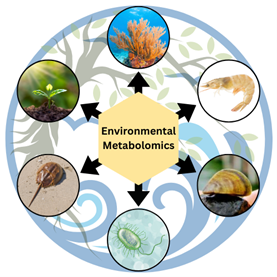Summary
The metabolomics program at NIST involves measurement research efforts in numerous biological systems, including cells, microbes, various aquatic organisms, and mammals, and is supported by analytical facilities that include a high-field nuclear magnetic (NMR) facility and a high-resolution mass spectrometry (HRMS) laboratory. By applying NMR, an unbiased discovery tool, and MS, a more sensitive tool, to investigate cellular and non-model systems, the program aims to bring new understanding to the biochemistry and molecular actions of each complex network and provide the foundational measurement science for the discovery of new commercial processes and products.
Description

The application of metabolomics techniques to systems biology reveals insights into model and non-model organism biology. The natural world contains undiscovered chemicals and mechanisms that can be harnessed by industry to create new biomanufacturing processes and products. Each biological system presents distinctive challenges that uncover critical requirements for rigorous study design and method development. Research in these systems will yield the introduction of new techniques, protocols, data tools and best practices for application to diverse measurement challenges in all arenas of metabolomics.
current projects
- Biomanufacturing Applications: New manufacturing technologies are leveraging biological organisms and natural processes to produce new products such as fuels, pharmaceuticals, materials, industrial chemicals, and more. Metabolomics is a tool that characterizes these cell-based biomanufacturing platforms by analyzing and understanding the metabolic pathways, fluxes, and mechanisms within cells used for industrial production. NIST’s role is to develop the measurements that provide insights into the cellular processes driving the synthesis of desired consumer products (e.g., proteins, metabolites, enzymes, biofuels, pharmaceuticals) and help to optimize these processes for industrial applications. Metabolic characterization and understanding, and cultivation of metabolic pathways enhances the ability to engineer biology, enabling data-driven optimization for efficient, sustainable, and cost-effective biomanufacturing.
- Biomedical Applications from Natural Products: Horseshoe crabs are vitally important organisms in the biomedical industry, due to the presence of amoebocytes in their hemolymph (blood), which can isolate bacterial endotoxins by quickly clotting around them. For this purpose, amoebocytes are extracted from horseshoe crab hemolymph to produce Limulus Amoebocyte Lysate (LAL), which is used to test for the presence of toxins in injectables and medical devices destined for the human body. LAL is also critical in the mass production of vaccines and has been essential in the development of vaccines for the SARS-Cov-2 virus (COVID-19). NIST is collaborating with the South Carolina Department of Natural Resources (SCDNR) and the College of Charleston using NMR-based metabolomics to investigate the physiological effects of age and temperature on blood chemistry, metabolism, and mortality of harvested American horseshoe crabs (Limulus polyphemus), to improve efficacy, sustainability, and production of this biomedical natural product.
- Bio-measurement Tool for Exposure:
- Mussels have been widely used as bioindicators in aquatic environments to evaluate ecosystem health by measuring contaminant levels in their tissue. However, measuring the metabolic response of the organism can evaluate the sum of stress initiators on organismal health rather than attempting to measure each individual chemical and physical challenge. NIST is collaborating with the National Oceanic and Atmospheric Administration’s (NOAA) Mussel Watch Program and the Great Lakes Environmental Research Laboratory to investigate metabolic changes that occur in Dreissenid mussels due to innate biological variation, such as reproduction, and natural environmental variations, to distinguish those responses from chemical exposure. The aim is to develop a bio-measurement strategy at the ecosystem level using these invasive mussels.
- The use of molecular -omics techniques to study coral health will improve understanding of coral biochemistry and the coral reef ecosystems that protect our shorelines. NIST develops robust field-sampling methods and optimizes -omics workflows for coral samples, to improve the quality of coral -omics data worldwide. Application of our workflows are being used to begin to understand the molecular pathology of coral growth anomalies, which can impair biological function, to characterize the metabolome of important reef building species exposed to harsh natural conditions, and to evaluate the coral-algae-microbiome synergy in temperate corals. The baseline biochemical information generated by –omics techniques cans clarify the mechanisms by which corals survive and fulfill their functional roles as key species for ocean and coastal ecosystems.

